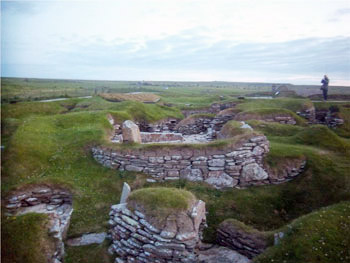
Scotland: The Orkney Islands
by Alexis Brett
Nestled on a small island just north of the Scotland mainland lies an ancient site that is just begging to be explored.
 Skara Brae, a prehistoric village that was built before the Egyptian pyramids, has been listed as one of the “Heart of Neolithic Orkney” World Heritage Sites, and it illustrates a perfect example as to why the Orkney Islands have often been referred to as “The Egypt of the North.”
Skara Brae, a prehistoric village that was built before the Egyptian pyramids, has been listed as one of the “Heart of Neolithic Orkney” World Heritage Sites, and it illustrates a perfect example as to why the Orkney Islands have often been referred to as “The Egypt of the North.”
Because of the many mysteries surrounding both the abandonment and the discovery of Skara Brae, researchers have coined the site as “one of the most remarkable discoveries in modern archaeology” as it contains one of the best preserved Neolithic villages known to mankind.
“Skerrabra”
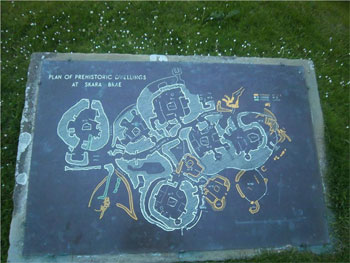 Skara Brae is approximately 5,000 years old and is located about eight miles away from the small town of Stromness on the southern shore of the Bay O’ Skaill. Although it was originally thought that the site was a Pictish village, researchers now believe that the settlement was actually an Orcadian village that was inhabited between the years of 3200 and 2200 BC.
Skara Brae is approximately 5,000 years old and is located about eight miles away from the small town of Stromness on the southern shore of the Bay O’ Skaill. Although it was originally thought that the site was a Pictish village, researchers now believe that the settlement was actually an Orcadian village that was inhabited between the years of 3200 and 2200 BC.
Even though it was deserted thousands of years ago, the village still remains in mint condition and to this day researchers still can’t pinpoint exactly why the last inhabitants left; which only adds to the mystery surrounding Skara Brae.
Skara Brae was discovered in 1850 after a severe windstorm “ravaged” the Orkney mainland and uncovered the land that was sheltering the abandoned settlement for thousands of years.
The first person to discover the site was William Watt of Skaill, who at the time resided at the Skaill House which is located no more than 200 metres away from Skara Brae. (Ironically enough the Skaill House is also said to be haunted as there have been reports of people seeing a ghostly figure of a woman wearing a shawl in one of the windows).
The Skaill House was built in 1620, and even though the Skaill family owned the house for two hundred years before the discovery of the village, none of its former residents had realized just what was sitting in their backyard underneath the piles of sand and dirt.
But it wasn’t until 1925 when another storm revealed even more of the village, and it was at that time when researchers truly realized the treasure that had been literally under their noses the whole time. A sea wall was then built to protect the newly discovered settlement, and soon after scientists uncovered a village with eight different houses, each of which were linked together by underground passages.
A day in the life of Skara Brae
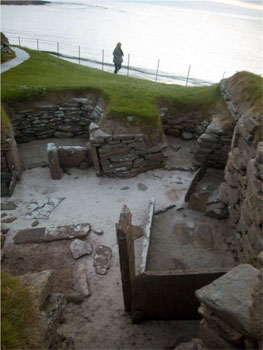 It is believed that Skara Brae was big enough to hold about 50 to 100 villagers at any given time, and that it was inhabited for approximately 600 years.
It is believed that Skara Brae was big enough to hold about 50 to 100 villagers at any given time, and that it was inhabited for approximately 600 years.
Because the village was built into mounds of “pre-existing rubbish” the village sunk underground and protected the village from any unwanted visitors and/or predators. Not only that, because the mounds of hills provided a much needed insulation for the homes, the people were also protected from the infamous Orkney windstorms which could last for days or even weeks at a time.
The walls of the village were built with sandstone slabs and the houses were covered with thatched roofs and possibly whale bones. Each of the houses were also designed identically with a fireplace in the center as well as two beds, dressers and storage units, and even a small fish-filled bait box made of stone that was built into the floor. The fireplace was used for cooking and heating and the stone beds were filled with bracken and heather for comfort, and they were also covered with animal skins for warmth as well.
The only building that differs from the rest is said to be the “Village Workshop” after numerous tools and stone-made weapons were uncovered when researchers were digging throughout the room. There is also another separate area which is believed to have been used as a modern-day compost as the inhabitants seem to have used it to store garden and waste materials.
Researchers also believe that the original occupants were very skilled in working with bone and stone because they found different items, tools and artifacts that were left behind in the settlement, (like elaborately-decorated pottery, needles, shovels, picks and weapons).
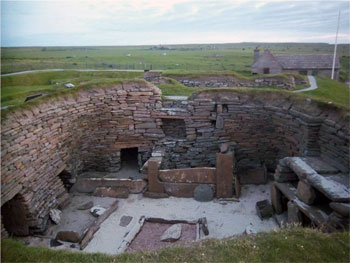 The villagers also used volcanic pumice that could have been washed up on the shore from Iceland to help shape the bone tools and stone balls, and over 2,400 inscribed beads and hundreds of bone necklaces were found in one of the stone cupboards as well. It is believed that many of these objects resembled one’s symbol of status or may even have been used for ritualistic purposes. It is also thought that the dressers which were sitting directly across from the doorway were used to “show off” any prized possessions and/or hunting trophies whenever a visitor entered the home.
The villagers also used volcanic pumice that could have been washed up on the shore from Iceland to help shape the bone tools and stone balls, and over 2,400 inscribed beads and hundreds of bone necklaces were found in one of the stone cupboards as well. It is believed that many of these objects resembled one’s symbol of status or may even have been used for ritualistic purposes. It is also thought that the dressers which were sitting directly across from the doorway were used to “show off” any prized possessions and/or hunting trophies whenever a visitor entered the home.
Although it is assumed that those who lived within the walls were a part of a tight-knitted community, experts still can’t decide as to whether there was a hierarchy among the villagers or whether the villagers were equal. And even though there hasn’t been a lot of evidence revealing any sort of religion and/or tradition within Skara Brae, researchers have associated the Skara Brae way of life with the traditional Orcadian beliefs in that the worship or ancestors, gods and spirits was more than likely the norm for the community.
After spending a great deal of time studying the surroundings of the settlement, it is also believed that the original inhabitants were farmers who raised cattle and sheep and possibly grew barley and wheat on the fertile land nearby. Their diet consisted of deer, seabird eggs and various other types of seafood like mussels, shellfish, oysters, crab, cod and saithe (aka pollock).
Given the fact that the sky covering the Orkneys remains dark for over half of the year, it is also said that the villagers more than likely used to gather within the homes of Skara Brae around a bonfire and tell stories and sing songs. And because the interior of the dwellings were windowless, researchers believe the rooms and passageways must have been extremely dark and smoky due to the fact that only one bonfire was placed in the center of each room.
An abandoned mystery
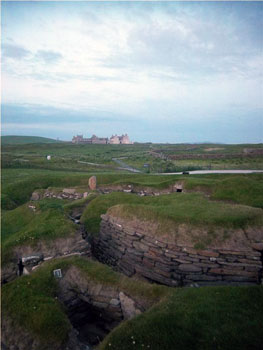 Because many belongings and artifacts were left behind in the village and stored carefully away in the cupboards, some believe that Skara Brae was abandoned because of an “apocalyptic” event and/or disaster which forced the villagers to flee their home.
Because many belongings and artifacts were left behind in the village and stored carefully away in the cupboards, some believe that Skara Brae was abandoned because of an “apocalyptic” event and/or disaster which forced the villagers to flee their home.
However, it is now thought that Skara Brae was abandoned because of coastal erosion as well as changes of the weather, especially because the villagers would have had to have been locked up inside their homes for weeks or even months at a time because of strong winds and storms which now are associated with the Orkney way of life.
Not only that, because Skara Brae is located next to the ocean, it would have been extremely difficult to maintain the village with the salt water splashing across the land and destroying the homes, and scientists now believe that the ocean was once much further away from the village than it currently is today.
So what happened to the inhabitants after they deserted their homes?
The answer is still unclear; however it is known that after Skara Brae was abandoned around 2200 BC and records show that the Vikings didn’t actually settle in the Orkneys until about 787 AD. And because researchers are struggling to determine exactly what happened to Skara Brae’s original inhabitants, it only adds more fuel to the mysterious fire surrounding the ancient village. But thousands upon thousands of tourists are drawn to the Orkneys each year not only to check out the haunting site for themselves, but to also view several other ancient sites scattered around the Orkney mainland as well.
Believe it or not, Skara Brae is just one of many examples of the haunting and mysterious sites on the Orkney mainland. Just five miles away are two stone circles – the Standing Stones of Stenness and the Ring of Brodgar – both of which can be compared to the likes of Stonehenge. (It is believed that the Orcadians at that time used both of the stone to monitor the stars, worship the gods, or perhaps even to mark the grave sites of authoritative figures in the village, but their purpose still remains debatable).
And not just seven miles away from Skara Brae also lies Maeshowe, the ancient tomb which was believed to have been built around 2700 BC. To add mystique to the site, researchers also discovered that sometime in the mid-12th century a group of Vikings entered the tomb and started to tag the walls with graffiti. Some of the many tags include “Thorni bedded Helgi” and “Ofram the son of Sigurd carved these runes.”
These are just some of the many examples as to why anyone who has a passion for archaeology and history should not only visit Skara Brae, but the other several ancient sites scattered around the largest Orkney island known as “Mainland” as well.
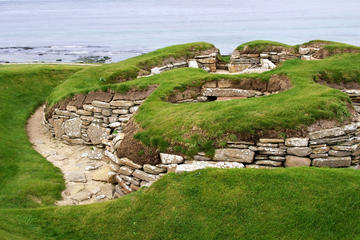
3-Day Orkney Explorer – Small Group Tour from Inverness
If You Go:
Undiscovered Scotland – Skara Brae
Neolithic Skara Brae Orkney, Scotland
For information on how to get there: http://www.britainexpress.com/scotland/ancient/skara-brae.htm
About the author:
Alexis Brett is a Canadian journalism graduate who works as a freelance writer and recently moved to the UK. You can read her travel tweets at @RambleOnEh.
All photographs are by Alexis Brett.



Leave a Reply
You must be logged in to post a comment.